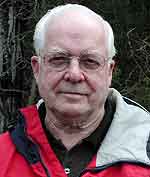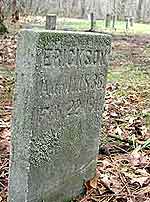By Dan Gunderson and Chris Julin
Minnesota Public Radio
July 29, 2002
| |
|
|
|
||
Earl Leaf retired from teaching junior high English about 20 years ago, and started writing his family history. And that's how he got interested in the Chisago County poorfarm.
He's written thousands of pages about Chisago County, where both his parents grew up. Earl Leaf has documented who's in the county's 40 cemeteries, and he's written biographical sketches of 2,000 people who died in the county.
But some of the people who died here are missing. He knows they're here - somewhere - because he's seen the death and burial records.
There's Johannah Lindgren, who was born in Sweden, and died in Chisago County about 1900. Olof Larson is here, too. He was a bachelor farmer and he died in 1899.
Earl Leaf figures they both died at Sunrise Farm. That was the county's first poorfarm.
But they didn't just die. They disappeared. Their graves are here, but there are no markers. Old maps show the poorfarm cemetery is in a farm field that now belongs to Orrin Asklund.
"Over there is where the poorfarm buildings were at one time," Orrin Asklund says, pointing to a field across a quiet county road.
He's standing in one of his own fields. He's lived on this farm for more than 40 years. He's talking with Earl Leaf, who stops by sometimes to talk about the bodies.
| |
|
|
|
||
"If we can believe the records were correct," says Leaf, "than there are at least 25 people buried here."
He knows their names from their death certificates. He knows they died here when this land was the poorfarm.
Orrin Asklund isn't sure. Maybe the bodies are here. Maybe someone dug them up years ago.
"There's no sign of anything now," Asklund says, as he looks around the stubbly, early spring field. "It's been plowed up for at least 70 or 80 years."
The county sold this patch of land to a local farmer in 1905. They charged him $1. Since then, it's been planted in corn or soybeans.
But not all of the old pauper cemeteries are hidden in farm fields. They've been found on college campuses, under parking lots, and in suburban construction sites.
In Fargo, people unknowingly visit the old poorfarm cemetery every day.
Next: Seeking dignity for the dead


